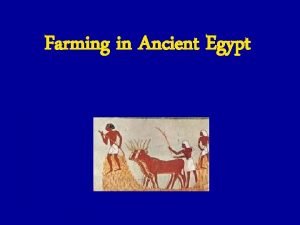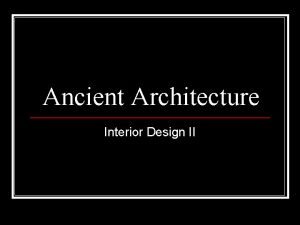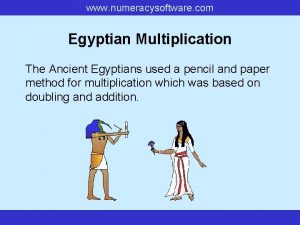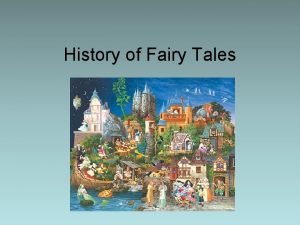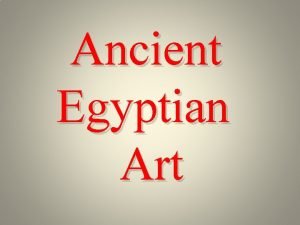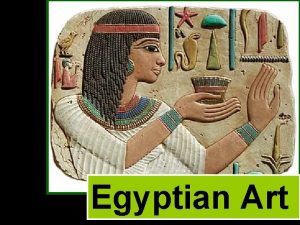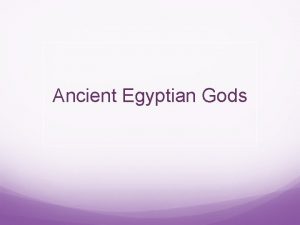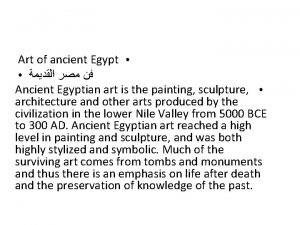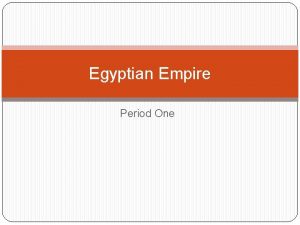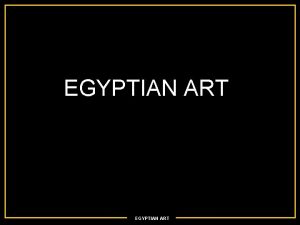Ancient Egyptian Art Intro to Egyptian Art Plato














- Slides: 14

Ancient Egyptian Art

Intro to Egyptian Art • Plato said Egyptian Art didn’t change for 10, 000 years. There is some truth to that statement. – Egyptian art stayed fairly consistent to certain rules/patterns – Some believe early priests set the rules and demanded all artists follow them for consistency.

Egyptian Art Conventions • Hierarchy scale- objects that are more important are shown larger than other objects/people – Kings and nobleman are usually the largest person in a work of Egyptian Art. • Women are typically painted lighter (and yellower), while men are darker (and redder). • People are generally depicted as young and in their prime. – Egyptians believed in an afterlife. Depicting people as young and healthy was a way of ensuring the deceased would be able to spend their afterlife in a young, healthy body forever.

Egyptian Conventions. The Human Body • Egyptians wanted humans to be portrayed in a way that was easy to understand. Therefore, all bodies were depicted like this: – Profile head – Full frontal (but single) eye – Full frontal torso – Profile lower body

Egyptian Art and Royalty • A great deal of Egyptian works of art documented/celebrated Egyptian Rulers. – Egyptian rulers were believed to be semi divine, in other words, they descended from the sun god, Ra. – Gods in Ancient Egypt were believed to have gold for skin. This meant that their skin would never decay. • When you see mummy masks that are painted gold, that means the person was considered semi divine, and the mask of gold will be his new face- always perfectly young.

Egyptian Architecture • When one thinks of Egyptian architecture, one usually just thinks of pyramids, but they also had temples, homes, etc. • The Sphinx is a 65 ft statue that has the body of a reclining lion and the head of a man. • The pyramids were tombs of deceased kings. – They were only a small part of a funerary complex – There would also be temples, shrines, etc.

The Funerary Complex of Hatshepsut • Hatshepsut was probably the first woman in history to be recorded as important. • She ruled Egypt for 22 years. • Under Hatshepsut, Egypt prospered and grew. She oversaw trading with faraway lands and commissioned many new buildings. • As you will see, the tombs of king’s were more than just pyramids.

The Palette of Narmer 3100 B. C. E. • Used as a palette of cosmetic application/mixing. • Is a wonderful example of the conventions of Egyptian Art. – Typical human body depiction- lower body in profile, torso in full front, and head in profile – Uses scale to show hierarchy. – Action is not emphasized. Instead, the picture is all about how it is organized.

Fragment of a Wall from Thebes 1450 B. C. E. • Things to note about this piece: – Use of scale. Who is largest? Why do you think that is? – How do the women look different from the men? – Note that the animals are portrayed very naturalistically. This is important because it means the Egyptians had the skill to portray humans naturalistically but chose not to.

Model Granary • Artifacts like this one were placed in the tombs of rulers and nobleman. • These workers were to go to afterlife with the deceased. There, they would be servants for the deceased.

King Tutankhamun • King Tut was not a major king. In fact, his tomb was much less lavish than other, more important kings. • Notice the gold skin of his mask- this was to represent the gold skin of gods, which never decays. • The cobra and vulture on the mask are symbols of Lower and Upper Egypt. They are his protectors.

Akhenaten. A Change for Egypt • Ruler of Egypt • He married Queen Nefertiti and was King Tut’s father. • He is important because he changed (or tried tothings returned to normal after his reign) some Egyptian standards. – Pushed for monotheism. • Worshipped Aten (or Ra) – He changed art, too. • Figures became more naturalistic. (Ex: Sculpture of Nefertiti) • People were depicted on more of a personal level. (Ex: Seeing Akhenaten with his family)

Quiz! Please answer in complete sentences. 1. Describe at least two techniques Egyptians used when portraying people. 2. Was Egyptian art naturalistic (realistic)? Why or why not? 3. How did Egyptians use scale in their art? 4. Who was Akhenatan and why might he be important to art historians? 5. Describe one work of art in the presentation that you thought was interesting. Why did it interest you?

You’re Finished! Please submit your quiz into the teal turn-in box. Thank you!
 Early american period floral design
Early american period floral design Ancient egyptian clothing for special occasions
Ancient egyptian clothing for special occasions Ancient egypt transportation
Ancient egypt transportation Roman floral design history
Roman floral design history What crops did egypt grow
What crops did egypt grow Egyptian social pyramid
Egyptian social pyramid Ancient egyptian interior design
Ancient egyptian interior design Ancient egypt frontalism
Ancient egypt frontalism Ancient egyptian toothbrush
Ancient egyptian toothbrush Ancient egyptian slaves
Ancient egyptian slaves Ancient egyptian method of multiplication
Ancient egyptian method of multiplication Ancient egyptian commoner clothing
Ancient egyptian commoner clothing Hans and gretel egypt menu
Hans and gretel egypt menu Ancient egyptian technology
Ancient egyptian technology Chapter 8 the ancient egyptian pharaohs test
Chapter 8 the ancient egyptian pharaohs test




